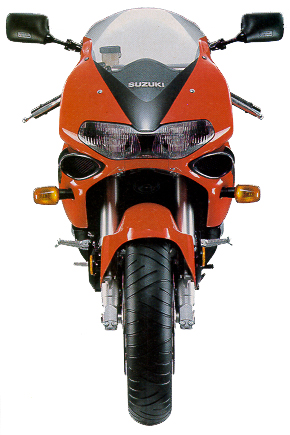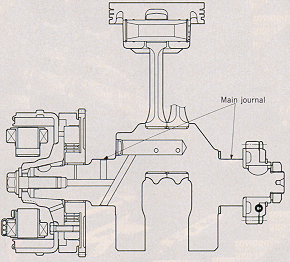Suzuki TL1000S: The Forgotten Sporting Twin
It's a tough world out there in sportybike-land. In the time it takes for rumor or spy shot of a supposedly quicker, tricker and faster future model to get published, your latest and greatest can quickly become relegated to yesterday's news. Even if its capabilities are right up there with the best, all it takes is the introduction of a flashier model with the promise of superior performance to push the previous bike into the shadows. Especially if the newer model comes from the same company and is trumpeted as a "racier" version of the original.
Such is the case with Suzuki's TL1000S. The all-new V-twin sportbike turned heads in '97 with its 113-horsepower, fuel injected powerplant and aluminumtrellis-style chassis. And its outright performance was a match for the competition at anything up to a ten-tenths, racetrack-scartching pace. Twin-cylinder sportbikes were all the rage and many of us were expecting the dawn of a new era in motorcycling, with narrow, lithe V-twins replacing the comparatively bulky in-line four as the dominant sporting-engine configuration.
But once news of the TL-S's racier brother --the TL1000R-- began to surface, everyone soon forgot about the S-model. With visions of a world-beating, V-twin sportbike dancing in their heads, many riders decided to stand pat and wait until the R-model's release. A somewhat sensationalized claim of a handling problem over in Europe, which forced a worldwide recall of S-models for retrofitment of a steering damper in order to quell a reputed tankslapping tendency (we never encountered this problem), definitely tainted the TL1000S as well.
Overlooked in all the excitement was a sportbike that was solid and capable in all respects. Sure, the R-model boated a twin-spar aluminum frame and hot-rodded motor, but it was also wider in the waistline and picked up 20-odd pounds in the transition. Was all this really worth an extra $500?
 The TL1000S's larger front fairing offers much better wind protection than the R-model's aerodynamically slanted windscreen. The mirrors offer a decent rearward view. |
One of our biggest gripes with the 97' TL1000S was its dismal fuel economy. We consistently averaged approximately 30 mpg during hard riding and were forced to refuel every 120 miles lest we end up pushing. Strangely, Suzuki isn't claiming any changes to the fuel-delivery maps on the '99 TL-S, yet we average about 33 mpg this time around. While this is not a huge improvement, it is a gain nonetheless. We did notice that the bike had an increased tendency to surge a little at light-throttle (cruise) settings around town, which may be indicative of leaner fuel-mixture mapping.
Riding the TL-s on city streets reveals two major changes since we last tested this model. One is a slight alteration to the clutch's back-torque limited ramp, and the addition of a sixth clutch spring. This significantly
smoothes out the TL's previous grabbiness during aggressive launches. The other is an unfortunate side effect of the steering damper. Although it may provide additional stability during spirited
canyon sorties, the nonadjustable damper also causes the steering to be somewhat truckish at slower speeds.
Maneuvering through traffic and tight confines is more of a chore. And while it's not lethargic by any means, steering response at higher velocities has been slowed,
requiring a bit more muscle for those quick-flick turn entries.
Get the TL out among those undulating
environs where quick turn entries are the name of the game, however, and
its rider-friendly chassis and strong motor have a chance to shine.
Although the steering requires more effort to initiate a turn, its overall
manners are dead neutral at all lean angles with the stock Metzeler
rubber. Ground clearance is abundant, so if you're scraping the
nonfeeler-equipped pegs you're probably riding a bit too fast for the
street.
The TL-S's 996cc, V-twin mill reminds us why we liked its overall
performance traits back in '97. While it may not quite pack the midrange
torque of some of its competition, the motor is clearly superior to the
R-model in this category; this, combined with its revy nature and strong
top-end punch, makes wheelieprone corner exits a breeze. And in cornering
scenarios where most in-line four sportbikes are trying to spin the rear
tire, the TL's smooth V-twin power pulses let the rider concentrate on
subjects other than traction control. The abrupt on/off throttle
transition of the Suzuki's fuel injection is still present though, so it's
best to get your drive started as early and smoothly as possible.
 One of the changes for '99 to the TL1000S is tighter clearance on the main bearing journals, reportedly to quell mechanical noises that are concealed by bodywork on the TL1000R. |
It may not look as stout as the TL-R's twin-spar chassis but the S-model's trellis-style, oval-tube frame is more than up to the task handlingwise, and it's far slimmer between the rider's knees than the R-model's rather bulky feel. Along with the aforementioned hospitable steering manners, the TL1000S's suspension does a very good job of absorbing the majority of pavement irregularities you're likely to encounter. Only at a very aggressive pace do any shortcomings appear: mainly softish spring rates that let the suspension nearly bottom-out in midcorner bumps, overpowering the rebound damping and causing the TL to weave a bit in protest. Nothing serious, but it does get your attention.
In this technological age of flash and speed, it's all too easy to overlook the good sportbikes that don't make a spectacle of themselves. The Suzuki TL1000S has always been a solid performer. It may have been forced to live in the TL-R's shadow but for those looking for a useful alternative to the all-out V-twin sportbikes currently making the rounds, at $8999, the Suzuki TL1000S remains a sensible choice.